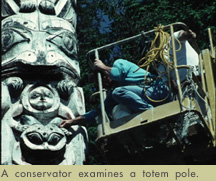 |
























|  |
 |
The objects in National Park Service (NPS) museum collections have a
long history. Some, for example, like Thomas Edison's laboratory equipment,
saw extensive use by their owners. Many archeological
objects deteriorated underground until archeologists excavated them. This long history has
left many of our museum objects too fragile to be used for
exhibit, research, education and publication. Others, like objects and photographic
negatives made out of cellulose nitrate plastics are unstable because
of problems with the original design and manufacture of the material.
First, the conservator does an
examination to identify structure, materials and condition of an object.
This examination may include scientific tests to identify materials
(structures and deterioration products) that are not immediately known. As
part of each examination, the conservator develops a treatment plan.
When a conservator examines an object, he or she is
defining the current state of the object. The conservator asks a series of
questions such as:
- What is it made of?
- How is it made?
- How has it deteriorated?
- Have other treatments been done?
- What could have caused the deterioration
- What do I need to know to halt the deterioration?
Each of these questions can lead to further testing. For example, when
examining a textile, the conservator will identify the kind of fiber that
is used to weave the textile. If the conservator plans to wash the
textile, he or she will test to be sure that the dye will not run.

|











